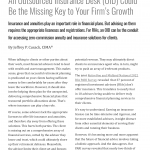Vanguard has measured a 30-40% chance for a recession by late 2020. The popular fund company (and manager of subaccounts in some of RetireOne’s solutions) base their prognosis on a couple of factors.
Writing in the New York Times, journalist Jeff Sommers says, “The recession projection is based largely on interest rate expectations using two criteria, according to Freddy Martino, a Vanguard spokesman. One is what economists refer to as a flattening yield curve, with the Federal Reserve expected to raise shorter-term rates faster than longer-term ones. The other is rising credit risk for below-investment-grade bonds.”
The risk for investors, as Vanguard sees it, is that, because of the current bull market, portfolios are weighted heavily to equities in the form of stocks. In the event of a recession, unless investors protect themselves, they could be vulnerable to big shocks.
The behavior we witnessed in 2008 was panic. Sommers says that folks sold for a loss at the bottom and weren’t able to participate in the early part of the recovery. It took longer for those portfolios to recover. Investors who sat tight took a few years to get their heads above water, and people who allocated 50% of their portfolios to bonds recovered in a third of that time.
While not advocating a particular strategy for navigating such choppy waters, Vanguard’s Fran Kinniry says, “You want to be prepared for a downturn,” without playing it so conservative that you miss out if and when the markets rise, as many did in the last recession.
With the recent addition to the RetireOne platform of low-cost, no-load index-linked annuities, RIAs have the ability to defend against losses in a recession, while still offering potential upside.
‘Floor’ elements of these solutions essentially ‘insure’ against losses beyond a certain level, say 5%. For that protection, the upside potential for the S&P-linked index is then capped at a level like 7.5%. Employing a ‘floor’ as part of a structured annuity essentially places a stopper on how far client losses can go and offers a defensive position for investors in years when they feel strongly that markets will fall.
‘Buffers’ offer a band of protection through a range of losses, say 0 to -10%. Advisors might use a buffer as an extra measure of protection when markets are expected to remain positive, or growth is expected to be strong. Capped participation rates for a buffer of -10% may be around 12 or 13% for the investment component (index) that’s linked to the performance of the S&P 500. Like any other investment, addressing client needs and risks should help determine whether a structured annuity might provide the right kinds of protections.
Clients nearing or in the first five years of retirement are facing sequence of returns risk, and these structured products may be a good place to start looking for safe haven, especially as low and rising rates may make fixed income less attractive than in years past.
It’s also a good time to look at those clients who’ve held variable annuities through this unprecedented bull market. If they seek downside protection with upside potential and they intend to protect principal for their heirs, stepping up the death benefit to take advantage of a decade of market wins may be in order. These structured annuities make that possible at no additional cost.
Bear in mind that Vanguard will revise their projections depending on the movement of those two measures: credit risk of non-investment grade bonds, and the flattening yield curve. Certainly anything can happen, but now may be a good time to begin cataloging your clients’ needs, and making plans to manage any coming risk.



